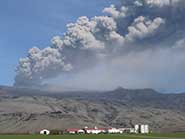PlumeRise is designed to give more accurate estimates of the amount of ash pumped into the atmosphere during a volcanic eruption, a vital piece of information for ash cloud forecasters.
It has already revealed that the 2010 eruption of Iceland’s Eyjafjallajökull volcano, which grounded planes and cancelled Easter holiday plans across Europe, may have unleashed up to 10 times more ash than originally thought.
Previous estimates relied on measurements of the height of the volcanic plume, but that approach is only reliable in still air. To take account of the effects of the wind, mathematicians and Earth scientists at the University of Bristol have combined their expertise to create a new mathematical model.
The model shows that strong winds prevent ash plumes from reaching as high as they would in calm conditions. This means that ash estimates that rely on plume-height measurements alone can dramatically undershoot the real figure.
Now the team have taken their research one step further, creating an online tool that could be used by scientists around the world to predict and monitor just how much ash is released during an eruption.
That information can then be fed into forecasts to give a more reliable prediction of how an ash cloud will spread, and how airspace will need to be managed accordingly.
Mathematician Dr Mark Woodhouse, one of the creators of PlumeRise, and lead author on the original study, said: "Our research represents an important development in our modelling of volcanic plumes. We've found that, for small explosive eruptions, like the one at the Eyjafjallajökull volcano in 2010, the wind can have a very significant effect on the plume of ash. This model can complement the state-of-the-art forecasting tools used to predict the spread of ash during volcanic crises."
Earth scientist, fellow author and co-creator, Dr Jeremy Phillips said: "The amount of ash released during an eruption, and the rate at which it is injected into the atmosphere, is an important input into meteorological simulations of ash cloud dispersal and is used directly by the Volcanic Ash Advisory Centres to provide information to the airline industry. We’re making this openly and freely available as a web-based tool to anybody who wants to use it."
PlumeRise has been tested by several of the Volcanic Ash Advisory Centres (VAACs) around the world including the Met Office London VAAC which covers the UK, Iceland and the north-eastern part of the North Atlantic Ocean. It is also being used by academic institutions in Japan, the Istituto Nazionale di Geofisica e Vulcanologia in Italy, and the Icelandic Meteorological Office.
PlumeRise is freely available for anyone to use at http://www.plumerise.bristol.ac.uk (registration required).
Paper on which PlumeRise is based:
Woodhouse MJ, Hogg AJ, Phillips JC, Sparks RSJ, ‘Interaction between volcanic plumes and wind during the 2010 Eyjafjallajokull eruption, Iceland’ in the Journal of Geophysical Research.
The work is part of the NERC-funded Vanaheim (Volcanic and Atmospheric Near-to far-field Analysis of plumes Helping Interpretation and Modelling) project. Vanaheim is a consortium of nine UK institutes (including the University of Bristol) and works with multiple international partners. The overarching aim is to ensure that the science and organisational lessons learned from the April/May 2010 emergency response to Eyjafjallajökull are translated fully into preparedness for future eruptions of other volcanoes.
PlumeRise received additional funding from the University of Bristol for the development of the web interface by Dr Chris Johnson, a mathematician at the University of Bristol.
